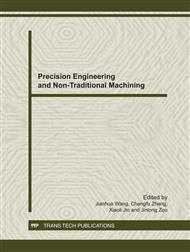[1]
Schuster R, Kirchner V, Allongue P, et al. Electro-chemical micromachining[J]. Science 2008; 289(5476): 98-101.
DOI: 10.1126/science.289.5476.98
Google Scholar
[2]
Ma Xiaoyu, Li Yong, Lv Shanjin, et al. Influence of electrolytic products in machining gap on Micro ECM[J]. Advanced Materi-als Research, 2009,60-61: 388-393.
DOI: 10.4028/www.scientific.net/amr.60-61.388
Google Scholar
[3]
McGenough J A, Leu M, Rajurkar K P, et al. Electro-forming process and application to micro/macro manu-facturing[J]. CIRP Annals—Manufacturing Technology 2010; 50(2): 499-514.
DOI: 10.1016/s0007-8506(07)62990-4
Google Scholar
[4]
Kim B H, Ryu S H, Choi D K, et al. Micro electro-chemical milling[J]. Journal of Micromechanics and Microengineering 2005; 15(1): 124-129.
Google Scholar
[5]
B.J. Park B.H.kim,C.N. Chu. The Effects of Tool Electrode Size on Characteristics of Micro Electrochemical Machining[J].Annual of the CIRP, 2006, (1):45-59.
DOI: 10.1016/s0007-8506(07)60397-7
Google Scholar
[6]
Hocheng H, Kao PS, Lin SC (2005) Development of the erodedopening during electro chemical boring of hole[J]. Int J .Adv Manuf Technol 25:1105–1112.
DOI: 10.1007/s00170-003-1954-x
Google Scholar
[7]
Cao DM, Jiang J, Yang R, Meng WJ (2006) Fabrication of high-aspect-ratio microscale mold inserts by parallel lEDM[J]. Microsyst Technology 12:839–845.
DOI: 10.1007/s00542-006-0131-1
Google Scholar
[8]
Friend J, Nakamura K, Ueha S (2004) IEEE ASME TransMechatron 9:467.
Google Scholar
[9]
Serre C, Yaakoubi N, Martnez Setal (2005) Sens Actuators APhys 123–124:633.
Google Scholar


